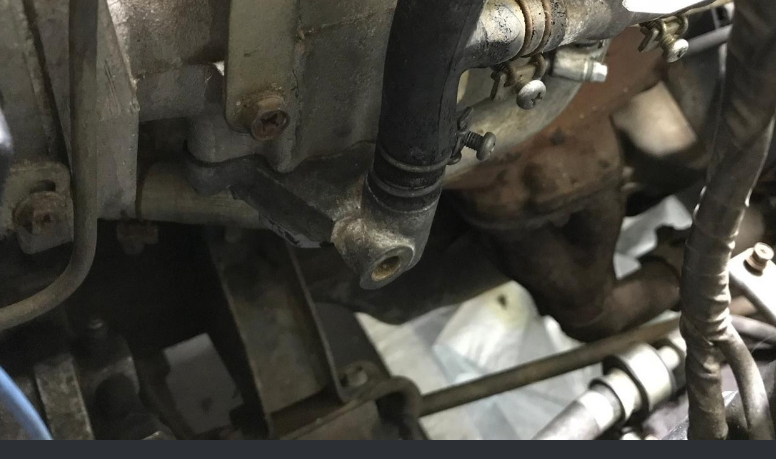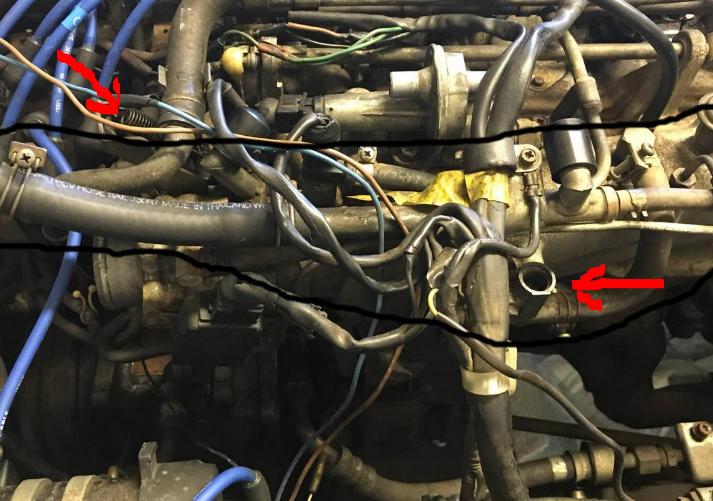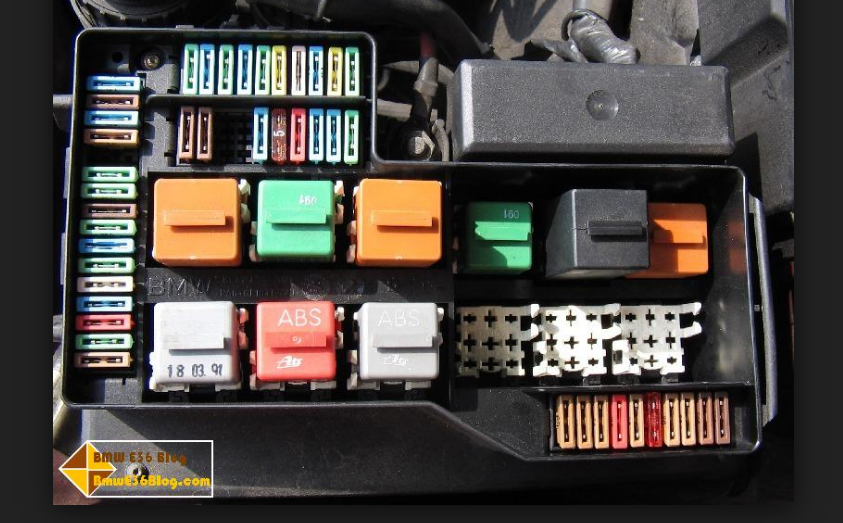Everything posted by Zed Head
-
Brake upgrade
Pretty sure I've seen people write about it. I seem to recall spacers being discussed. Are you really in India?
-
1977 280Z with 81-83 engine, persistent 2000-2500rpm high idle
The big hose is T'ed with the idle speed control air bypass. So a simple plug at the end of the hose or at the mechanism itself should work . Looks like the bypass feeds directly in to the intake manifold. Follow the air flow path from one side of the TB, through the screw controlled idle controller, and to the intake manifold to be sure. You need to be aware though, that removing the BCDD will bring back the original problem it was meant to fix. You'll have a gassy smelling car if you coast to a stop while in gear. You might end up wishing you had fixed it. The 81-83 ZX's have a mass of vacuum controlled devices that can leak. Here's another. Which brings up another reason for idle speed to increase - ignition timing. You might have a sticky vacuum advance mechanism n your distributor. Pretty common. There are are also thermally controlled vacuum valves placed around the engine. Can't remember how many.
-
1977 280Z with 81-83 engine, persistent 2000-2500rpm high idle
I have a ZX manifold in the garage if anyone needs a BCDD.
-
1977 280Z with 81-83 engine, persistent 2000-2500rpm high idle
I thought that the plate would go directly on to the manifold with all of the hose connections removed. But I think I see what you're showing now. Those hose connection is still there. Nissan shows an interface. I wonder if that piece can be removed and plated there.
-
1977 280Z with 81-83 engine, persistent 2000-2500rpm high idle
The FSM picture looks pretty clean. It's probably where the hoses were connected. But you do also need a good solid seal on whatever blockoff plate you attach also.
-
1977 280Z with 81-83 engine, persistent 2000-2500rpm high idle
You can check for the stuck throttle blade by pulling up on the pedal with your foot or manipulating it by hand under the hood. There are two return springs, one on the TB itself and the other attached to the linkage. On the ZX engines I think that the linkage spring is very visible, right on top. I snipped ypur picture and drew an arrow to the spring and linkage, Make sure it's free and working right. Also arrowed the ZX idle adjustment screw. It works by letting a small amount of air past the throttle blade. If you figure out the excess air problem you'll still have the goofy ECU problem. That could be a loose connection or a bad ECU. Is it a ZX ECU or the original Z ECU? They're different. Should be next to your left foot, behind a panel. With a sticker on it that ID's it. Take a picture of the sticker. It's probably the Z ECU and they are known for failing like yours is, with the tapping it rich/lean problem.
-
R180 3.90 gears?
I've only heard of Nissan and Subaru using the R180. Maybe he meant Datsun 4x4 pickup. The Toyota 4x4 disc brake calipers are used though.
-
1977 280Z with 81-83 engine, persistent 2000-2500rpm high idle
Engine speed is controlled by the amount of air it can get. It's always trying to get more. So if you want to reduce engine speed you have to reduce the amount of air available. The quantity of fuel available will only control the quality of the engine speed, not the quantity. The quantity of fuel in a gasoline engine is always match to the amount of air, to control the qulaity of the combustion. So, your first task should be to control the quantity of air getting in to the intake manifold. The throttle blade should control almost all of it, especially since the BCDD is gone. One area that people tend to miss is the PCV system. It is connected to the intake manifold and the engine's crankcase. So any air that gets in to the crankcase, like through the valve cover, can get in to the intake manifold, and cause a high idle. Normally, extra air would cause some increase but a little more would cause a decrease as the mixture gets too lean. But, if the ECU or FPR is allowing extra fuel, the extra air can cause the idle to rise a lot since there is extra fuel to go with it. The PCV diagram in the Emissions chapter is worth studying. It will give some ideas about where excess air could be getting in and which hoses to plug or connect properly.
-
Starter question
It will work but the 280ZX starters have more torque, I believe. They are gear reduction starters. The cone nose is a 240Z to 280Z type starter. It's a regression. You can use 280ZX starters on Z's and vice-versa.
-
Gasoline dripping out of air intake ports
I think that the pins are held in place by the sides of the bowl. Once assembled they can't get out. Have you examined the valve itself? As I recall, they're typically a rubber coated pointy piece that sits in a precision ground hole. The float presses it in to the hole as it rises. The rubber can get hard or take a set or have a groove worn in it over time, and not seat properly anymore.
-
Info on BCDD - Boost Controlled Deceleration Device
The oil would have come from the PCV system. Nissan redesigned the PCV hose routing in 1977 to avoid blowby fouling of the throttle body. I'm pretty sure the CO has been in to the BCDD machinations, and that siteunseen has "tuned" his for better operation. They might have some suggestions.
-
Info on BCDD - Boost Controlled Deceleration Device
Not sure what you mean by "dry" but I would only use a small amount of sealant around the edges of the diaphragm, if any at all, if it looks like the rubber won't seal. The device is only meant for air to pass through and be diverted to desired places. Also hope that you marked your starting points so that you can be close to correct adjustment when you put it back together. There is at least one thread on the site about adjusting the BCDD, even though Nissan says to never take it apart, just replace it. @siteunseen @Captain Obvious
-
Fully restored 1975 280Z. Rebello Racing stroker 3.0L. Immaculate condition!
Really nice car. But, it's not "restored". Restored means taking it back to original condition. Not sure exactly what a better term would be (resto-mod sounds kind of goofy), but restored is going to draw a different type of looking-to-buy type than what you're selling.
-
Failing Valve Guides?
That's a fuel pressure gauge. 5 psi might be a little high for Webers, but I don't know Webers. Float bowls and valves are all similar though and 5 seems a bit on the high side. AFR stands for Air Fuel Ratio (even though air actually contains fuel) and AFR meters are used to help make adjustments to hit a certain fuel air ratio. But the old school ways will work also. No offense Travel'n Man. People have tuned many carbs before AFR meters came about. They're great for fine tuning but he can make a lot of progress just by eye, and butt, from where he's starting.
-
Failing Valve Guides?
I should say that failing valve guides is not a bad guess, although seals would be more specific. They will leak more oil at idle under high intake system vacuum and dirty up the plugs pretty quickly. Then when you start driving much of that will burn off. My original engine had bad seals and would run rough after putting around town, then would clear up after I gave it one of those high rev tune-ups. It was fun for quite a while to have a reason to go beat on the engine, trying to figure out why it ran so much better afterward. After I removed the engine and took the head off, I noticed oil draining down the intake and exhaust valves after just a little while. The seals weren't sealing at all. There's quite a bit on the site about changing valve seals. Pretty easy, I think, and might make a big difference. In short - I second madkaw's thought, in Post #2.
-
Stuck Heat Lever
That's quite a write-up. I was thinking of your other article when I mentioned that something might be in the Technical area.
-
1978 280 WIW
This site is supposed to be based on actual sales. Pretty sure they start with a a running engine and drivable car though. Your money... https://www.hagerty.com/apps/valuationtools/1978-datsun-280z https://www.hagerty.com/valuationtools/Classifications-and-Conditions https://www.hagerty.com/valuationtools/About-our-prices
-
Failing Valve Guides?
You should add your car details to a sig, or at least tell people what you're working with in your posts. Pretty sure it's a 240Z, based on the stuck heat lever post. Looks like the plug was firing for a while. Need all of the details on the engine though, and the plug, to make a better guess.
-
Another Engine, another mystery. Another day in the life...
I've wondered if a loose chain alone is enough to allow the valves to hit the pistons. Doesn't seem like it should unless the camshaft can some how rotate faster than the crankshaft is pulling it, from inertia. The inertia of the mass would have to overcome the valve springs and friction. Maybe at high revs, on a downshift, or something similar. With no tensioner on the loose side there would be a lot of slack to over-rotate on, if it's possible, even if the sprocket timing was right on the tight side.
-
Stuck Heat Lever
I think that you need to remove the console and the whole assembly to get behind the panel. It's probably shown in the FSM. Might be in the site's Technical area also. I had a similar problem. The lever pushes and pulls on a stiff cable. If somebody gets aggressive on the push, the cable bends and shortens up. Then it acts like a spring and won't allow the knob to come back. I straightened mine out and had it working for a while but eventually I replaced it with a piece of piano wire.
-
1978 280 WIW
For buying purposes I'd start at about $4,000 (no offense site), since it doesn't run. It could take a lot of work. But it all depends on why you're buying it. If you're buying it to restore, it might be worth more. If you're buying it to drive, and you don't know a lot about old cars, it could be worth a lot less since you'll be spending much time and money on it. If you're buying it as a project to work on for fun, 3-4 seems about right, if it's in the shape it seems to be in. Interior parts in good condition are really hard to find, and most old 280Z's, especially in your part of the country, are very rusty. Probably depends on who's selling it and why, also. If the original owner is selling it, he/she might think it's of high value. If it's an estate sale or similar, an easy sale might be in order.
-
Another Engine, another mystery. Another day in the life...
What are you planning for this old war horse?
-
Relay Mounting Locations - Firewall? under dashboard
You might consider repurposing a BMW or Ford or other late model car's relay and fuse box. Ford and BMW and several others have a nice weatherproof plastic box with a cover that they mount in the engine bay or under the front cowl. Lots of slots for whatever variety of relays and fuses you like. Found this picture on the internet, for example. 1997 BMW.
-
OK to get the S30 wet?
I live in Oregon and drive in the wet often, but it's clean water. My car has some rust, but it's under the battery tray from lead salts from the battery. Good luck resisting. Wheel spray from your car and others will travel. Salt works fast.
-
Sticky EFI thread, please chip in FI guys!
You can't think like this with the 280Z EFI system. Just doesn't work. The only emissions stuff of note on a 75 280Z might be the EGR system, for a CA model. There's an extra ignition pickup in the distributor too, but you can't see it.











